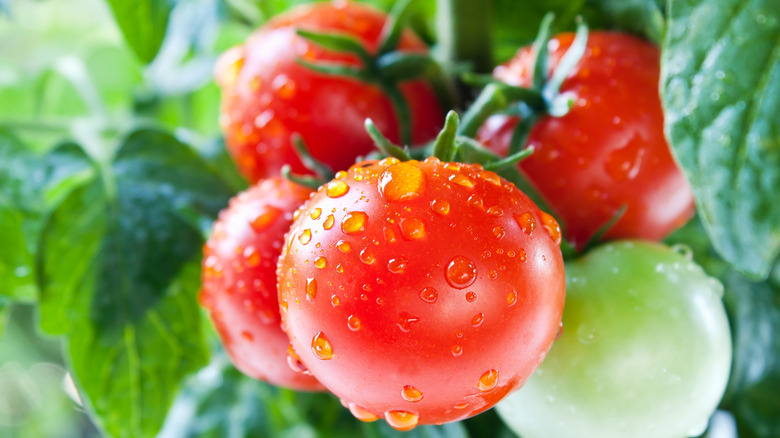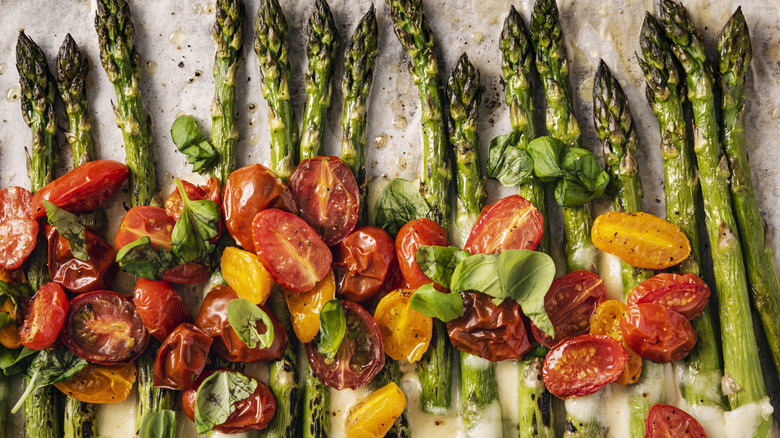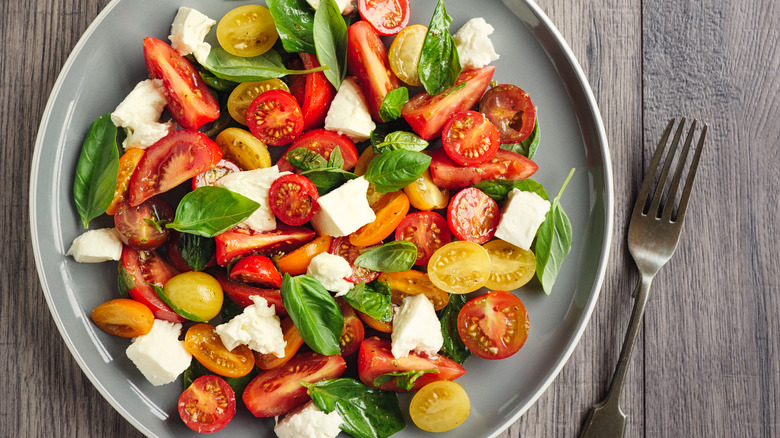The Flavor Difference Between Cherry And Grape Tomatoes
There are few things as satisfying as the burst of flavor upon biting into a cherry tomato picked straight from the vine or tossed into a refreshing summer salad with feta and pine nuts. But have you ever wondered about the flavor differences between cherry tomatoes and their similar-looking, petite tomato counterparts, grape tomatoes? And can you swap one for the other in recipes?
First, it's important to know how to spot each tomato variety, especially when you find the little tomatoes sold seasonally in cute paper baskets at a summer farmers market, where they may not be labeled. Appearance-wise, cherry tomatoes are perfectly round, and sometimes will still have their stems intact. Grape tomatoes are oblong in shape and a bit smaller (about half the size), and are harvested in clusters like grapes.
While both cherry and grape tomatoes pack a juicier, concentrated flavor-forward bite compared to larger types of tomatoes, with cherry tomatoes these qualities are especially pronounced. Cherry tomatoes are typically sweeter and juicier than grape tomatoes, and quite literally are bursting with flavor. Their sugary nature has even been described as particularly fruity (especially yellow and orange varieties, like the Sungold cherry tomato). Alternatively, grape tomatoes are heartier to the bite and their flavor is more similar to that of a beefsteak or roma tomato — earthy, with a balance of sweetness and acidity.
Cherry tomatoes have an extra juicy sweetness
The particularly juicy flavor of cherry tomatoes can be attributed to the higher moisture and sugar content of the variety. As with other produce, growers measure the sugar content of the fruit with a measurement called Brix readings. Average larger slicing tomato varieties usually have a greater balance of acidity and sweetness, with a Brix ranging between 3.5 and 5.5, according to Simple Seed. Perfectly ripe cherry and grape tomatoes can range up to 10 Brix, with cherry tomatoes falling on the sweeter end of the spectrum compared to grape tomatoes.
Cherry tomatoes also have a thinner exterior skin compared to grape tomatoes, so you'll get that delicate burst of abundant inner juices upon popping cherry tomatoes into your mouth. Whereas, grape tomatoes have a thicker skin and are generally more meaty, providing a more bit, texture, and fleshy substance.
Though cherry tomatoes are particularly juicy and sweet, both cherry and grape tomatoes will deliver a sweet pop of flavor compared to your typical Roma tomato, making both varieties great for tossing into salads or using as a vibrantly eye-catching garnish. Both cherry and grape tomatoes can often also be found in beautiful colorful combinations and selections. Red, purple, or black varieties of both cherry and grape tomatoes typically are more acidic, complex, and savory, while orange and yellow types are more candy-like and deliver sweetness.
How to choose your tiny tomatoes
In most cooking and eating situations, cherry and grape tomatoes can be swapped one for another. So, it's no big deal if your local store only has a carton of grape tomatoes in stock when your recipe calls for cherry. In fact, grape tomatoes may be easier to find in grocery stores, especially in off-seasons, since their thicker skin and lower moisture content lend them to a longer shelf life and greater ease of transport without blemishing and spoiling.
However, if you're going for an extra sweet flavor burst, choose cherry tomatoes when they are available and fresh, and eat them within a couple of days of bringing them home. Toss sweet cherry tomatoes in pasta salads or together with mozzarella for a caprese tomato salad, or slice them in half and place them atop slices of crisp baguette for a classic bruschetta, basil, and mozzarella for a quick caprese appetizer; don't forget the balsamic drizzle!
Grape tomatoes will generally last longer and are great for adding to lunchtime salads over the course of a week. Their heartiness is also ideal for cooking applications — sauces, veggie roasts, or dips — where leaking juices won't be as much of a problem.
Note that with both cherry and grape tomatoes (or any tomatoes for that matter), it's best to store them at room temperature for optimal taste and texture, as the refrigerator tends to make them mealy and flavorless. Whichever petite tomato you choose, be sure to savor each bite.


